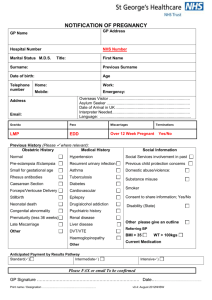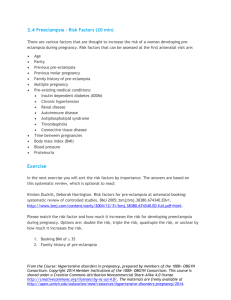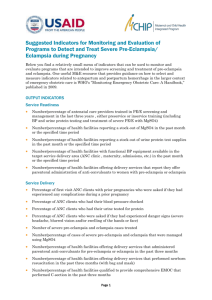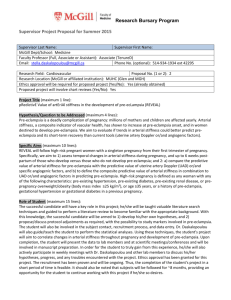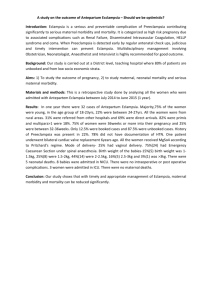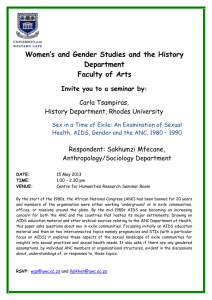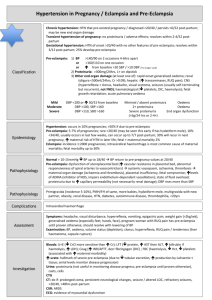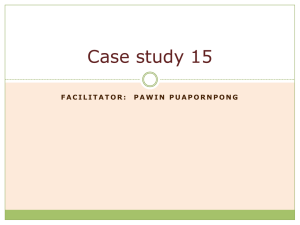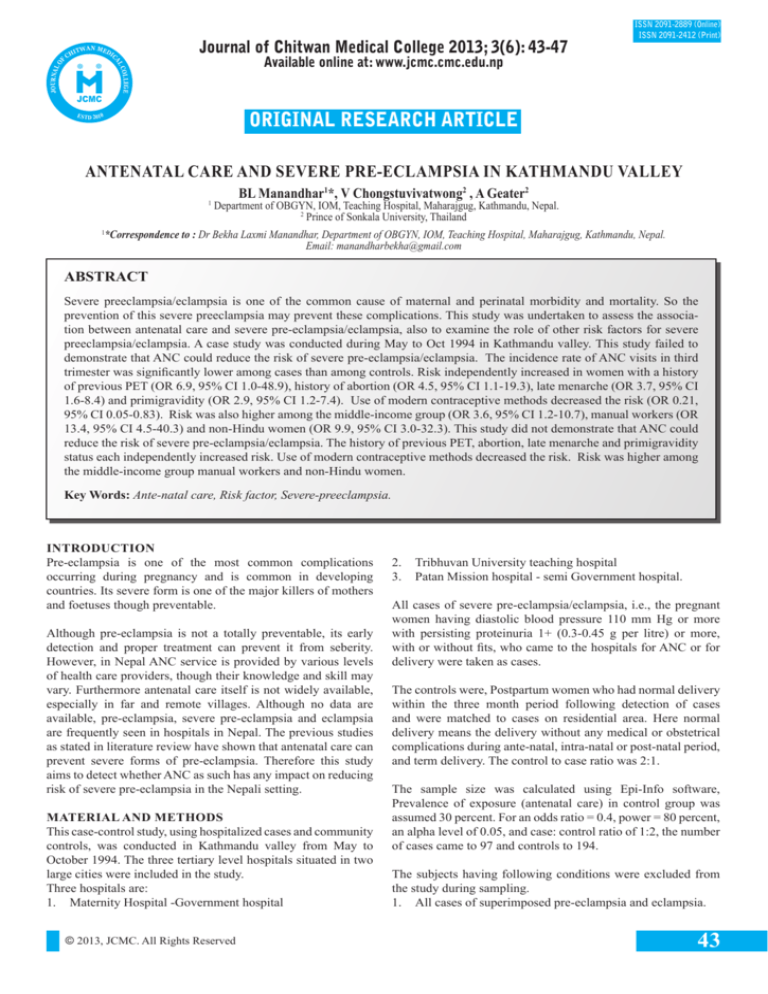
OF
Journal of Chitwan Medical College 2013; 3(6): 43-47
C
Available online at: www.jcmc.cmc.edu.np
COLL
JCMC
EGE
JOURN AL
T W A N ME DI
AL
I
CH
ISSN 2091-2889 (Online)
ISSN 2091-2412 (Print)
ORIGINAL RESEARCH ARTICLE
ESTD 2010
ANTENATAL CARE AND SEVERE PRE-ECLAMPSIA IN KATHMANDU VALLEY
1
BL Manandhar1*, V Chongstuvivatwong2 , A Geater2
Department of OBGYN, IOM, Teaching Hospital, Maharajgug, Kathmandu, Nepal.
2
Prince of Sonkala University, Thailand
*Correspondence to : Dr Bekha Laxmi Manandhar, Department of OBGYN, IOM, Teaching Hospital, Maharajgug, Kathmandu, Nepal.
Email: manandharbekha@gmail.com
1
ABSTRACT
Severe preeclampsia/eclampsia is one of the common cause of maternal and perinatal morbidity and mortality. So the
prevention of this severe preeclampsia may prevent these complications. This study was undertaken to assess the association between antenatal care and severe pre-eclampsia/eclampsia, also to examine the role of other risk factors for severe
preeclampsia/eclampsia. A case study was conducted during May to Oct 1994 in Kathmandu valley. This study failed to
demonstrate that ANC could reduce the risk of severe pre-eclampsia/eclampsia. The incidence rate of ANC visits in third
trimester was significantly lower among cases than among controls. Risk independently increased in women with a history
of previous PET (OR 6.9, 95% CI 1.0-48.9), history of abortion (OR 4.5, 95% CI 1.1-19.3), late menarche (OR 3.7, 95% CI
1.6-8.4) and primigravidity (OR 2.9, 95% CI 1.2-7.4). Use of modern contraceptive methods decreased the risk (OR 0.21,
95% CI 0.05-0.83). Risk was also higher among the middle-income group (OR 3.6, 95% CI 1.2-10.7), manual workers (OR
13.4, 95% CI 4.5-40.3) and non-Hindu women (OR 9.9, 95% CI 3.0-32.3). This study did not demonstrate that ANC could
reduce the risk of severe pre-eclampsia/eclampsia. The history of previous PET, abortion, late menarche and primigravidity
status each independently increased risk. Use of modern contraceptive methods decreased the risk. Risk was higher among
the middle-income group manual workers and non-Hindu women.
Key Words: Ante-natal care, Risk factor, Severe-preeclampsia.
INTRODUCTION
Pre-eclampsia is one of the most common complications
occurring during pregnancy and is common in developing
countries. Its severe form is one of the major killers of mothers
and foetuses though preventable.
Although pre-eclampsia is not a totally preventable, its early
detection and proper treatment can prevent it from seberity.
However, in Nepal ANC service is provided by various levels
of health care providers, though their knowledge and skill may
vary. Furthermore antenatal care itself is not widely available,
especially in far and remote villages. Although no data are
available, pre-eclampsia, severe pre-eclampsia and eclampsia
are frequently seen in hospitals in Nepal. The previous studies
as stated in literature review have shown that antenatal care can
prevent severe forms of pre-eclampsia. Therefore this study
aims to detect whether ANC as such has any impact on reducing
risk of severe pre-eclampsia in the Nepali setting.
MATERIAL AND METHODS
This case-control study, using hospitalized cases and community
controls, was conducted in Kathmandu valley from May to
October 1994. The three tertiary level hospitals situated in two
large cities were included in the study.
Three hospitals are:
1. Maternity Hospital -Government hospital © 2013, JCMC. All Rights Reserved
2. Tribhuvan University teaching hospital
3. Patan Mission hospital - semi Government hospital.
All cases of severe pre-eclampsia/eclampsia, i.e., the pregnant
women having diastolic blood pressure 110 mm Hg or more
with persisting proteinuria 1+ (0.3-0.45 g per litre) or more,
with or without fits, who came to the hospitals for ANC or for
delivery were taken as cases.
The controls were, Postpartum women who had normal delivery
within the three month period following detection of cases
and were matched to cases on residential area. Here normal
delivery means the delivery without any medical or obstetrical
complications during ante-natal, intra-natal or post-natal period,
and term delivery. The control to case ratio was 2:1.
The sample size was calculated using Epi-Info software,
Prevalence of exposure (antenatal care) in control group was
assumed 30 percent. For an odds ratio = 0.4, power = 80 percent,
an alpha level of 0.05, and case: control ratio of 1:2, the number
of cases came to 97 and controls to 194.
The subjects having following conditions were excluded from
the study during sampling.
1. All cases of superimposed pre-eclampsia and eclampsia.
43
Manandhar et al, Journal of Chitwan Medical College 2013; 3(6)
2. Pre-eclampsia/eclampsia with any other medical
complications.
3. All cases of severe pre-eclampsia with any obstretrical
complications, such as twin pregnancy, molar pregnancy
etc. The reason for excluding these cases is that exposure to
ANC tends to be increased in these group.
4. Preterm deliveries (deliveries before thirty seven weeks of
gestational age) were also excluded from controls
eclampsia and eclampsia.
* = Excluding four cases who did not have chance to do ANC
in third trimester.
Four cases of severe pre-eclampsia developed between 25 and
29 weeks of pregnancy and therefore were not at risk of exposure
to ANC in the third trimester. Omitting these 4 cases from the
analysis failed to reveal any negative association between ANC
visit and severe pre-eclampsia.
RESULTS
Incidence of pre-eclampsia and eclampsia.
The total number of deliveries in the three hospitals during the
study period, May 1994 to Oct 1994, was 4,709 and the total
number of cases of severe pre-eclampsia including eclampsia
was 94. So the ratio was 20 cases of severe pre-eclampsia or
eclampsia to one thousand hospital deliveries.
Onset of ante-natal care and severe pre-eclampsia/ eclampsia.
Women who subsequently developed severe preeclampsia/
eclampsia tended to attend antenatal clinic earlier than controls.
Table 2. shows the proportions of women in each outcome
category attending ANC before and after three different cut off
points.
Among the 94 cases of severe pre-eclampsia including eclampsia
nineteen of these cases, were excluded from the study for the
following reasons:7 were from outside the Kathmandu Valley,
6 had heart disease, 2 had essential hypertension, 2 came from
remote villages and 2 had twin pregnancy. Of the remaining 75
cases, 15 had eclampsia. Two cases of severe pre-eclampsia and
four cases of eclampsia developed after delivery at home.
Ante-natal care in each trimester and severe pre-eclampsia/
eclampsia.
Severe pre-eclamptic patients had a higher exposure to ANC in
first and second trimesters than did the normal delivery group.
Exposure to ANC in the third trimester was approximately equal
in both groups (Table 1).
Table 1: The association between attendance of ANC in each
trimester. SPET/EC vs ND. Crude odds ratios (OR) and
95% CI. Reference group is ND.
__________________________________________________
Number (percent)
Variable
______________________________________
ND
SEPT/EC
OR
95% CI
N=150
N=75
__________________________________________________
Attendance of ANC:
First trimester
No 122 (81%)
Yes
28 (19%)
52 (69%)
23 (31%)
1
1.93
Second trimester
No
88 (59%)
Yes 62 (41%)
30 (40%)
45 (60%)
1
2.13
1.21-3.74
Third trimester
No
83 (55%)
Yes
67 (45%)
43 (57%)
32 (43%)
1
0.92
0.53-1.61
1.01-3.65
* Third trimester
No 83 (55%)
43 (61%)
1
Yes
67 (45%)
28 (39%)
0.96
0.54-1.69
__________________________________________________
Note : ND = Normal deliveries, SEPT/EC = Severe pre-
44
Table 2. Association of onset of antenatal care using three
differnt components. Crude odds ratios and 95% confidence
intervals. ND is the reference group.
___________________________________________________
Number(percent)
Variable
ND
SPET/EC OR 95% CI
N=150 N=75
___________________________________________________
First trimester
25 (17%) 23 (31%)
1
Second and third or none 125(83%) 52(69%) 0.45 0.23-0.87
First and second
Third or none
First, second and third 65 (43%) 46 (61%)
1
85 (57%) 29 (39%) 0.48 0.27-0.85
69 (46%) 53 (71%)
1
None
81 (54%) 22 (29%) 0.35 0.19-0.64
___________________________________________________
Pattern of ANC in relation to normal delivery and SPET/
EC.
Various pattern of ANC timing were reported. Table 3 shows
the relationship of the pattern to outcome, using attendance for
ANC in all trimesters as the baseline. Pattern of ANC timing
in which ANC was stopped before third trimester were more
common among cases than among controls. Not having any
ANC, however, was less common among cases than controls,
but the difference was not statistically significant.
Table 3. Pattern of timing of ANC according to outcome
ND and SPET/EC. Crude odds ratios and 95% CI. ND, the
reference group.
__________________________________________________
Variable
ND
SEPT/EC OR
95% CI
n=150
n=75
___________________________________________________
1st+2nd+3rd
25
12
1
1st+3rd,2nd+3rd,3rd
42
20
0.99
0.41-2.36
1st+2nd, 2nd, 1st
2
21
21.80 4.30-108.9
ANC not done 81
22
0.56
0.24-1.30
___________________________________________________
Reproductive status and socio-demographic factors as risk
© 2013, JCMC. All Rights Reserved
Manandhar et al, Journal of Chitwan Medical College 2013; 3(6)
for SPET/EC
Risk of SPET/EC was increased in women with no education,
who were manual workers, in a middle income group, nonHindu, primigravidae and who had a history of abortion or PET
and menarche after the age of 13 years. Use of modern family
planning methods decreased the risk of SPET/EC Table 4.
Table 4. Adjusted odds ratios and 95% confidence intervals
of socio-economic and reproductive status factors in
developing severe pre-eclampsia.
___________________________________________________
SPET/EC
Variable ───────────── *χ2 df P value
Adj.OR (95% CI)
___________________________________________________
Patient’s education:
None
1
14.52
3 0.002
Primary
0.16
0.05-0.59
Secondary
0.12
0.03-0.42
Intermediate + 0.09
0.02-0.53
Husband’s education:
None
1
18.86
Primary
0.78
0.17-3.57
Secondary
5.24
1.05-26.3
Intermediate+ 22.22 2.97-165.9
Occupation:
Housewife
1
26.72
Manual worker 13.42 4.47-40.25
Others
0.66
0.21-2.11
3
0.000
2
0.000
2
0.004
Income:
No income
Up to 3000 Rs
3000 Rs +
1
3.6
1.2-10.7
2.5
0.75-8.5
Religion:
Hindu
Non-Hindu
1
15.78
9.9
3.04-32.32
1
0.000
Gravidity:
Multigravidae
Primigravidae
1
2.9
1.17-7.39
5.7
1
0.017
History of PET:
No
1
Yes
6.9
0.99-48.9
4.04
1
0.044
History of abortion:
No
1
Yes
4.5
1.06-19.3
4.14
1
0.042
Use of FP:
No
Yes
6.92
1
0.009
26.62
1
0.000
1
0.21
0.05-0.83
Age of menarche:
< 14 yrs
1
>= 14 yrs
3.72
1.65-8.39
© 2013, JCMC. All Rights Reserved
10.82
___________________________________________________
* = change in -2 log likelihood for deletion of the factor from
the model.
DISCUSSION
This study was undertaken to examine the association between
exposure to antenatal care and the risk of developing severe
pre-eclampsia among women living in Kathmandu Valley. No
straight relationship was found. However, varied patterns of
ANC visits throughout the pregnancy were reported. Subjects
developing SPET/EC differed from those having normal delivery
in more commonly attending ANC in the second trimester and
less commonly attending in the third trimester, irrespective of
their attendance for ANC at other times during the pregnancy.
The odds of stopping ANC before the third trimester compared
to having ANC in all 3 trimesters were higher among subjects
developing severe pre-eclampsia and eclampsia than among
those having a normal delivery. In another study, conducted at
Aberdeen Maternity Hospital,1 however, failure to have ANC in
third trimester was shown to be a risk factor for pre-eclampsia.
An increased likelihood of 2nd trimester and the generally earlier
onset of ANC among cases, suggests that the outcome of SPET/
EC in our study was not associated with a disregard for ANC
by these subjects during their pregnancy. It is not reasonable,
however, to conclude that ANC in the 2nd-trimester itself
increases the risk of developing severe pre-eclampsia. A more
satisfactory explanation is that subjects who would ultimately
become severely pre-eclamptic were attending ANC more
commonly than were subjects who ultimately had a normal
delivery, possibly because of the appearance of early symptoms
(“mild” pre-eclampsia??) during this period. It is not likely
that they were doing so because of the experiences of PET in a
previous pregnancy, such a history had almost no effect on the
association between outcome and pattern of ANC.
This would mean that ANC, in the 2nd trimester at least, was
not preventing the subsequent development of severe PET.
Sixty percent the cases had had second trimester ANC. This
is consistent with a study conducted in South Africa, 2 which
reported that improvement in ANC had no effect on the
prevalence of eclampsia, although it did reduce mortality from
EC.
Both reproductive history and socio-economic characteristics
had significant influences on severe pre-eclampsia.
Primigravidity, history of PET, history of abortion, and late
menarche independently increased the risk of PET while use of
modern contraceptive method decreased the risk.
It is well accepted that the pre-eclampsia is essentially a disease
of primigravidae irrespective of age. Even if the hypertensive
disease does develop in a subsequent pregnancy, it tend to be
less severe.3 However, a recently (1987-1991) undertaken casecontrol study at New York Mt. Sinai Medical Center could
not find any significant association between primigravidae
and pre-eclampsia,4 but the explanation given was that most
of the multiparous patients were impregnated by new partners
making them equivalent to the nulliparous or primigravidae4.
45
Manandhar et al, Journal of Chitwan Medical College 2013; 3(6)
An earlier study done in North California during 19841985 also did identify primigravidity as a risk factor for preeclampsia.5 Though since this time, many others reports have
also shown primigravidity to be a risk factor for pre-eclampsia,
the underlying mechanism is still not clear. Several reports3
have assumed an immunological basis for the mechanism. This
theory of immunology is strengthened by the finding that preeclampsia after early abortion was similar to the incidence for
a first pregnancy, but after a late spontaneous abortion the risk
was significantly reduced.6 The risk attached to primigravidity
could be confounded by age, as primigravidae in general tend
to be younger than multigravidae.3,7,8 However, in our study age
turned out to be not a significant predictor of risk although there
was a slight but non-significant increase in risk with increasing
age. In the Nepali setting, an alternative explanation, related to
social factors, for the increased risk associated to primigravidity
might exist. Women of younger age, and/or at first pregnancy,
may be unable to explain their problems to other members of the
family leading to the late health-seeking practice and thus failure
to detect pre-eclampsia early, with consequent risk of severe
preeclampsia. It is common in Nepal for young married women
to be dominated by the in-laws’s family, that so they can not
express their need for health examination. Social factors may
indeed play more vital role in setting like Nepal where mother
in-law have the dominant role in family decision-making.
Similarly to many other studies, the present study also found a
positive link between history of pre-eclampsia and the severe
pre-eclampsia in the index pregnancy.4,5 Again this could be
related to the immunological theory because studies have found
that pre-eclampsia developing in subsequent pregnancy tends to
be less severe.3
Perhaps this lessened severity could be due to proper
management of the disease at the proper time in subsequent
pregnancies as a consequence of the mother’s past experience.
Existing hypertension or renal diseases could lead to repeated
attacks of pre-eclampsia, but would not provide an explanation
for the finding of the current study as patients having essential
hypertension and renal disease were specifically excluded.
Regarding history of spontaneous abortion, this study indicates
that it increases the risk of severe pre-eclampsia after adjustment
for socio-economic factors. Most previous studies, however,
have shown spontaneous abortion to be a protective factors,9
It is possible that differences in the timing of spontaneous
abortion could be responsible for the discrepancy. Unfortunately
the gestational age at the time of abortion was not asked. One
study failed to show a significant association between history of
abortion and pre-eclampsia.4
The elevated risk of SPET/EC related to late menarche shown
by this study could be a new finding. No previous reports have
been located which have addressed this factor, and an obvious
biological explanation is lacking. Age of menarche itself is
determined by a combination of hereditary, environmental and
nutritional factors, so that the association between late menarche
and SPET/EC could represent two outcomes of a common
underlying cause. Current medical science agrees that age of
menarche is decreasing and rate of this decrement is correlated
46
with the improvement in nutritional factors.
The only protective factor for pre-eclampsia detected is the
use of modern family planning methods. Among the users of
family planning methods, 80% used DMPA, 8% used OC, 8%
IUD and 4% condom. Whether the effect could be related to
effect of progestagenic hormones is not known. A previous
study reported that use of barrier contraceptive methods carries
increased risk of SPET.10
Among the socio-economic variables, manual workers were
found to be at elevated risk for severe pre-eclampsia, although
there is no documented evidenced that physical activity is
associated with increased incidence of pre-eclampsia. Bedrest, however, has been an effective method of treating preeclampsia.3
The middle income group, earning up to 3000 Rs per month,
were shown to be at greater risk of SPET/EC than the no income
group. This is contrary to the finding of most other studies and
present concepts that low socio-economic class is a risk factor
for pre-eclampsia because higher socio-economic status means
better access to health facilities. The data suggest that women
with even higher income may be at somewhat reduced risk,
although this was not statistically significant. The finding that
the “no income” group may be at reduced risk could be because
this group was composed mostly of students and housewives,
who tend to belong to well-to-do families, and so represent a
rich and educated group.
Even after adjusting for income, non-Hindu were at a
considerably greater risk of SPET/EC than Hindus. Genetic
differences could be involved as the religious groups in Nepal
are ethnically distinct. The lifestyles of different religious
groups also tend to differ and this includes differences in diets.
As detailed dietary information was not obtained in this study,
it was not possible to control for the differences in diet. In this
connection it may be relevant that obesity has been recorded as
a risk factor for severe PET.4
Education, especially women’s education, is taken as an
important contributing factor in the improvement in general
health standard of a population. The association between SPET/
EC and education, shown in our study, are interesting, in that
SPET/EC was significantly associated with lower education in
mothers, but very strongly related with higher education of the
husband. While marriage between more highly educated men
and lower educated women are common and reverse extremely
rare, this does not seem to provide an obvious explanation for the
complex relationship between education and SPET/EC. Other
studies have shown PET to be common among women of low
education.9 No study has previouly reported inverse association
with husband’s education. The finding of the current study might
be peculiar to Nepali situation.
© 2013, JCMC. All Rights Reserved
Manandhar et al, Journal of Chitwan Medical College 2013; 3(6)
CONCLUSION
This case-control study did not demonstrate that ANC could
reduce the risk of severe pre-eclampsia/eclampsia among
women in Kathmandu valley. Rather, women who developed
SPET/EC had started ANC earlier than had controls with
normal delivery. On the other hand, a history of previous PET,
history of abortion, late menarche and primigravidity status
each independently increased risk. Use of modern contraceptive
methods decreased the risk. Risk was higher among the middleincome group manual workers and non-Hindu women.
REFERENCES
1. Hall MH, MacGillivray I, Chng PK. Is routine antenatal
care worth while? Lancet 1980; 12:78-80.
2. Moodley J, Daya P. Eclampsia: a continuing problem in
developing countries. Int J Gynecol Obstet 1993; 44:9-14.
3. The hypertensive disorders of pregnancy: report of WHO
study group. World Health Organization Technical Report
Series 758. Geneva: World Health Organization, 1987.
4. Stone JL, Lockwood CJ, Berkowitz GS, Alvarez M, Lapinski
R, Berkowitz RL. Risk factors for severe preeclampsia.
Obstet Gynecol 1994; 83(3):357-61.
5. Eskenazi B, Fenster L, Sidney S. A multivariate analysis of
risk factors for preeclampsia. JAMA 1991; 266(2):237-41.
6. Campbell DM, MacGillivray I, Carr-Hill R. Pre-eclampsia
in second pregnancy. Brit J Obstet Gynaecol 1985; 92:131140.
7. Cunningham FG, MacDonald PC, Grant NF. William’s
Obstetrics: Hypertensive Disorders in Pregnancy. 18th ed.
Connecticut: Appleton and Lange, 1989.
8. Dutta DC. Textbook of Obstetrics including Perinatology
and Contraception: Hypertensive Disorders of Pregnancy.
2nd ed. Calcutta: New Central Book Agency, 1987.
9. Klonoff-Cohen HS, Savitz DA, Cefalo RC, Mccann MF.
An epidemiologic study of contraception and preeclampsia.
JAMA 1998; 262:3143-7.
10. World Health Organization. International Collaboration
Study of Hypertensive Disorders of Pregnancy. Geographic
variation in the incidence of hypertension in pregnancy.
Am J Obstet Gynecol 1988; 158:80-3.
© 2013, JCMC. All Rights Reserved
47

